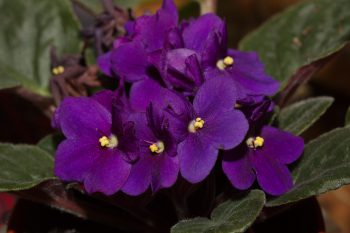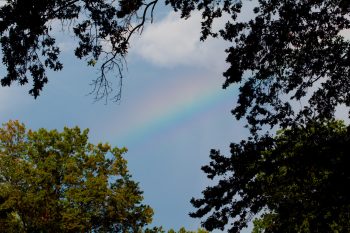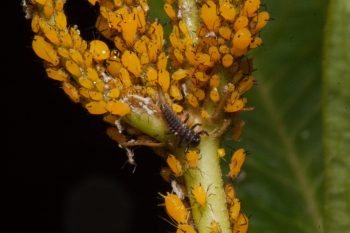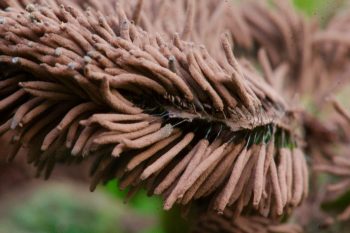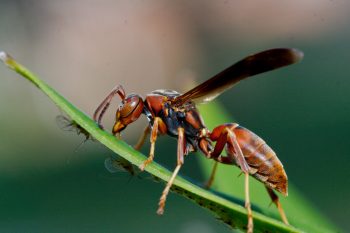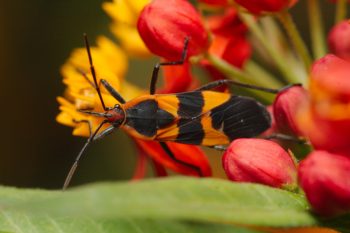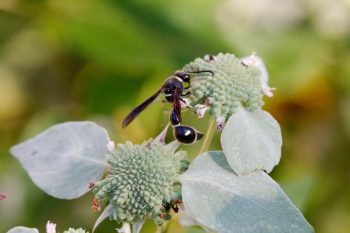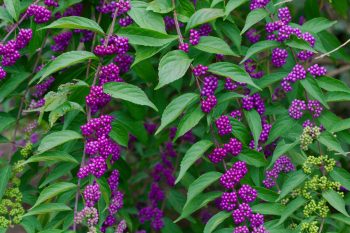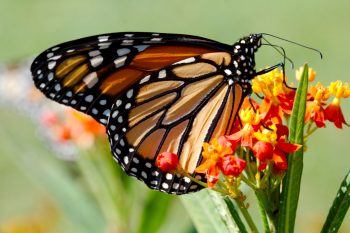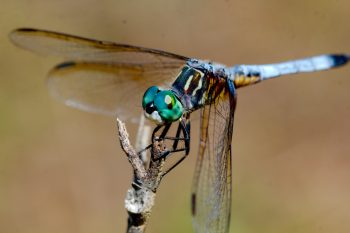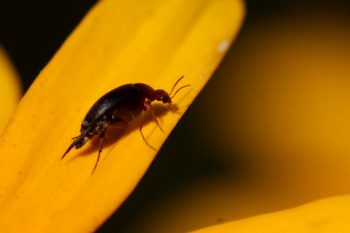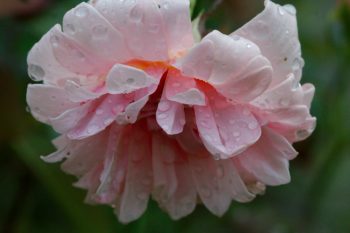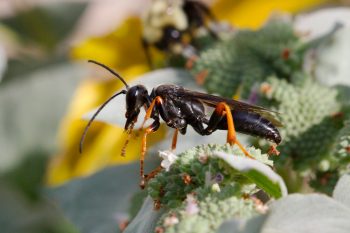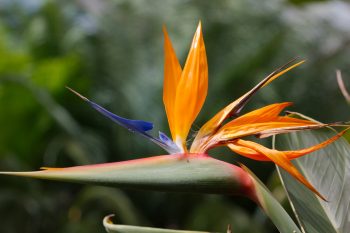We’ve had mixed success with houseplants over the years. When we’re not too busy, we can do reasonably well and houseplants thrive. When we’re busier, anything not particularly resilient is in pretty significant peril. Lately we’ve done reasonably and we have two African violet plants, cultivars of Saintpaulia ionantha, that arew doing well and blooming. We also have a iddle leaf fig (Ficus lyrata) that Dorothy started by rooting a leaf. It’s now about 6 feet tall and seems quite happy.
African Violets
Rainbow
When I left work today, I drove through a little rain. By the time I was nearly home and I stopped at the grocery story, the sky was partly cloudy. When I came back out from the store the sky was turning very dark and shortly after I got home and had unloaded the groceries, it started coming down quite hard. It only rained for about fifteen minutes and then the sun was back out again. I went out front and found a spot where I could see the rainbow. It was a bit early in the evening for a really good bow, but there was some down low in the sky. They are often tricky to photograph and this one was not as strong as many I’ve seen but it was pretty and I especially like the fact that this photo shows the rainbow against blue sky, which is pretty unusual.
Bombus impatiens (Common Eastern Bumble Bee)
Who doesn’t love the humble bumble bee? They are everywhere and like many of us, they are not particularly flashy or flamboyant. Nevertheless, they busily go about their business. I like them quite a bit and enjoy watching them move from flower to flower. In this case, a common eastern bumble bee (Bombus impatiens) is on wingstem, also known as yellow ironweed (Verbesina alternifolia). There were also honey bees (Apis mellifera) and ailanthus webworm moths (Atteva aurea) on the same group of flowers. It had become quite hot again, with temperatures in the low 90s, and I’m starting to look forward to autumn.
Cosmopepla lintneriana (Twice-stabbed Stink Bug)
I was out photographing flowers this evening. The light was fading and I didn’t think I could realistically get any photos of bees, wasps, or other flying insects. I was down on the ground to get some pictures of obedient plant, Physostegia virginiana, and I happened to notice this little fellow. I went in and got my flash, so I could get pictures that were worth something and I’m pretty happy with the results. This little bug (a true bug in the Heteroptera suborder) is only two or three millimeters long and if I hadn’t been down on the ground and very close, I never would have seen it. It is a twice-stabbed stink bug, Cosmopepla lintneriana. This one happens to be a nymph (an immature) and when adult will be mostly black with two red patches (the two “stab” marks of its common name).
Aphids and Lady Beetle Larva
I mentioned the aphids on the Asclepias curassavica (scarlet milkweed) when I posted the photo of the large milkweed bug a few days ago. Here’s a picture of the aphids. It was fairly dark when I took this (7:45 in the evening) and I used a flash to light them, which allowed me to get reasonable depth of field. I used a flashlight give me enough light to focus, with the camera on a tripod (which I definitely should use more often). As I was taking the pictures, I realized the aphids were not alone. There is a larva of a lady beetle of some sort (probably an Asian lady beetle, Harmonia axyridis), feeding on the aphids. Unfortunately, there are too many aphids for this lone predator, and I’m going to need to take care of them myself.
Stemonitis splendens (Chocolate Tube Slime Mold)
Cathy spotted this growing in our back yard and said I should come take some pictures. It was late in the day and the light was fading so they didn’t turn out as well as I would have liked. These are the sporangia of a slime mold (or mould in England). I believe it is Stemonitis splendens, the so-called chocolate tube slime. These don’t do any harm to garden plants, despite their somewhat alarming appearance. They actually live on the surface of leaves and are not actually parasitic. They feed on decaying organic matter and actually move in a way that seems more animal than vegetable. They form finger-like projections which then pull the body of the slime mold along. Creepy (literally!). From the Mississippi State University Extension Service:
When the slime mold is ready to reproduce, at some point during spring or summer generally following a period of rainy weather, it “crawls” up on grass blades, lower stems and foliage of landscape plants, the surface of landscape mulch, or even garden hoses. From these locations, the slime mold releases millions of dusty-gray spores.
Lunch with George and Carmela
Cathy and I drove up to George and Carmela’s today for a short visit. We had no trouble with traffic and we made pretty good time. We didn’t stay long but George had prepared a really nice lunch with homemade sourdough bread with robust olive oil spread on it and then covered with ripe, fresh tomatoes and sprinkled with feta cheese and Sicilian oregano. Obviously there are a lot of good flavors but fresh, very ripe tomatoes, served at room temperature, have to be right up there. These were wonderful and the corn on the cob as good, too. Of course, the visit was the main thing, and it was nice to have a few hours together before we turned around and drove home.
Paper Wasp
There are a few paper wasps that are very difficult to distinguish and some that are impossible without examining them at the microscopic level. A number of them are quite variable, as well, adding to the difficulty. I think this is a northern paper wasp (Polistes fuscatus) but I’m nowhere near sure. It’s a beautiful creature, whatever it is. This was taken with my 100mm lens with the addition of a 25mm extension tube in bright evening sunlight. As you can see, I was able to get fairly close and I’m pleased by how sharp this turned out. You might also notice the aphids on the underside of the leaf the wasp is on. I took some photos of those, as well, but haven’t identified them yet (beyond the generic “aphid”).
Oncopeltus fasciatus (Large Milkweed Bug)
It’s milkweed bug time in the garden. Cathy and I are both big fans of pretty much any species of Asclepias. This one is Asclepias curassavica, often known as scarlet milkweed. It’s growing in a container on our back patio and it really attracts the insects. I had a photo of a Monarch (Danaus plexippus) on it recently and today’s photo is of the aptly named large milkweed bug (Oncopeltus fasciatus). We also have a good colony of oleander aphids (Aphis nerii) and I may publish a photo of those, unless we get around to taking care of them before I do that. Like many insects that feed on milkweed, these bugs accumulate toxins from the plants which can “potentially sicken any predators foolish enough to ignore the bright colors which warn of their toxicity.” (bugguide.net)
Moon At Dusk
We had a pretty nice sunset this evening and I took a few pictures (aren’t you surprised?). Most of the best color was behind the trees to the south of our yard, so it was hard to capture. To the east there was some good color and I was able to get some nice pictures in that direction. To the west, most of the clouds were various shades of grey. There were a few low clouds that would light up and then go back to grey. I hoped to time the photo so that I could get both the moon and the lit clouds but they basically alternated. When the moon wasn’t behind the cloud, the color was mostly gone. Then the color would return just as the clouds covered the moon. This one has a little color in the clouds, anyway.
Eumenes fraternus (Potter Wasp)
This potter wasp (Eumenes fraternus) is one of my favorite wasps (doesn’t everyone have favorite wasps?). There’s fairly common around here. While they are particularly drawn to the mountain mint (Pycnanthemum muticum), they are also found regularly on the black-eyed Susans (Rudbekia) and painter’s palette (a.k.a. knotweed, Persicaria virginiana). I think it’s their clean lines that I like. They’re difficult to photograph well and I’m not really happy with this photo, although it’s the best I was able to get. They don’t really stop moving and unless the light is very strong, it’s hard to get both adequate depth of field and a short enough exposure to stop their motion.
Callicarpa americana (Beautyberry)
I’ve mentioned the beautyberry (Callicarpa americana) we have in our back garden so I thought it deserved a photo. Its berries are just about at the height of their beauty right now, so it seemed like the best time. As you can see, the berries are both beautiful and plentiful. Because this shrub blooms (and therefore sets berries) on new growth, it can be cut back fairly hard each autumn or early spring and it will still produce a good display. The flowers are not particularly significant, being tiny and very pale pink. The berries, as the name implies, are the reason to grow this native. It attracts birds, who eat the berries, which is also nice.
Cathy Weeding
Cathy and I have been trying to recover from the small amount of work we did in the garden in 2018. This year has been mostly recovery mode without a lot of additions but a lot of pulling and digging, trying to get at least some parts of the garden back to more garden plants than weeds. It’s an up hill battle. Along the back fence there was a huge stand of goldenrod, pokeweed, and bindweed. Cathy dug up a bunch of roots a few weeks back and we worked a bit more on it this weekend. As you can see, the central bed is full of black-eyed Susan’s and we have the volunteer American beautyberry (Callicarpa americana) growing there (the purple berries on the left). We dug out a bunch of weeds there last week, as well. Tomorrow I plan to dig up some roots that remain from the maple trees that used to be there.
Danaus plexippus (Monarch)
The butterfly weed (Asclepias) growing in a container outside our back door is very attractive to insects but particularly so to monarchs (Danaus plexippus). Lately we’ve had two of them on it at once and occasionally three. I got a few pictures of the two today but I think this is a better portrait of this handsome butterfly. I really enjoyed sitting and watching them flutter around the flowers, stopping occasionally at other plants but generally preferring the butterfly weed.
Pachydiplax longipennis (Blue Dasher)
I’ve been meaning to get out of the office for a short walk to the empty lot next to my building for over a week now. The upper part, where it was mostly mugwort, milkweed, and goldenrod has been mowed and it looks very different. I don’t know if this is a prelude to actual building plans coming to fruition. Plans to develop it started at least 25 years ago and the top soil was scraped up into a large mound that now has mid-size trees on it. There are a few drainage ponds and they are all abuzz with insects and birds. I saw a green heron when I first got there and then photographed a few dragonflies, including this blue dasher (Pachydiplax longipennis).
Tumbling Flower Beetle
I didn’t get any really good pictures today. It was after 6:00 when I went out and there wasn’t much insect activity this evening, for some reason. I did come across this little beetle, about 5mm long, on the petal of a black-eyed Susan. I think it’s a Tumbling Flower Beetle in Family Mordellidae (possibly in Genus Mordellistena, but I am really unsure). It’s a cute little thing and I was only able to get a few pictures before it flew off.
Rose In The Rain
It’s been pretty dry lately. Not drought dry, but normal August in the DC area dry, which is dry enough for me. I’ve never been attracted to deserts and am happy when rain comes (within reason). We had a good rain today. Not the all-day soaking rain we’re more likely to get starting in September but a good rain, nonetheless. When it had mostly stopped, I took a few pictures of water droplets on leaves, starting with the leaves of this rose. It’s the China rose ‘Perle d’Or’ just outside our front door and it’s happily blooming and doing very well after being killed back a little last winter.
Sphex nudus (Katydid Wasp)
The bees and wasps are out in force these days. I spent a little time around the mountain mint (Pycnanthemum muticum) this afternoon and enjoyed the variety of buzzing insects (most of them are basically silent, actually). The most numerous are the bumble bees (Bombus impatiens) and the large but gentle carpenter bees (Xylocopa virginica). The wasps are pretty well represented, though, and today I saw a handful of these katydid wasps (Sphex nudus) as well as some potter wasps (Eumenes fraternus). I got a few photos of that last one, but they weren’t as good as I would have liked. I’ll keep trying.
Lobelia siphilitica (Blue Cardinal Flower)
This is a really nice plant. Blue cardinal flower, Lobelia siphilitica, is an easily grown, herbaceous perennial, native to eastern North America and hardy to USDA zone 4. It needs fairly moist soil and does better here in part shade, where the ground doesn’t dry out so much, or in full sun in pots where it gets regular watering. It blooms over a fairly long period, which is always appreciated. One thing I didn’t know about it is that the species name of siphilitica is from “a prior medicinal use of the plant in the treatment of venereal disease.”
It does well in our garden and we have it scattered around. This particular plant is growing in a container on the driveway with black-eyed Susans behind it. Blue and yellow is always a good combination in the garden and with yellow being so prominent in ours, adding that touch of blue is great.
Bird of Paradise Flower
Cathy, Margaret, and I went to Brookside Gardens this afternoon. It was such a wonderfully beautiful day we were not surprised by the number of people there. Nevertheless, we were able to find a parking spot and wonder around the garden for a while. We often go there in the spring, when early flowers are in bloom. I would recommend that highly but this was a different experience. We rarely come in August because it’s so brutally hot. Today was in the mid-70s, though, and absolutely lovely. The summer flowering plants were at their best and we really enjoyed the gardens. The conservatory is always nice, of course, and this photo of a bird of paradise flower (Strelitzia reginae) was taken there. I’ve often thought about growing one of these but never got around to it. They are, apparently, fairly easy to grow, although they couldn’t take our winters and would need to come inside when it gets cold.

